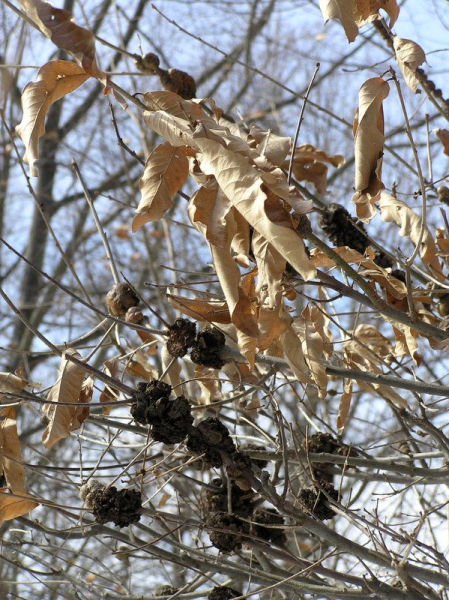
Last week I wrote about willow beaked-galls. Today it’s galls in trees.
This is a shingle oak, a member of the red oak group that grows in the Midwestern U.S. from Missouri to western Pennsylvania, from Lake Erie to central Tennessee.
Shingle oaks have laurel-like leaves whose edges are not lobed, but they are rumpled. It’s often easy to identify shingle oaks in winter because some of the leaves persist on the tree and the tree is prone to Gouty Oak Galls(*), those dark woody masses you see on the branches above.
Gouty oak galls are caused by a tiny wasp who lays its eggs on the leaves and twigs of oaks. The wasp’s eggs and larvae contain a chemical that causes the tree to grow malformed balls around the larvae. Since the wasp prefers not to travel far from its host, succeeding generations lay eggs in the same tree and thus this tree has many galls.
The galls don’t hurt the tree unless they overwhelm it, but that doesn’t usually happen. And since shingle oaks are not commonly cultivated, people don’t feel obligated to solve the gall problem — which insecticide cannot solve anyway.
As you look for migrating birds in the bare trees, take a look at the branches. You never know what you’ll find.
(photo by Dianne Machesney)
(*) p.s. If you are an oak gall expert and these are not gouty oak galls, please correct me!
Wow, what great timing for this article! My husband and I are looking to buy a piece of property to build a house, and one of the properties we looked at in the past few weeks had a number of trees full of galls on the property. I am not really good with tree identification, so I couldn’t identify the type of trees, and when I looked up galls on the internet found that there were many types of trees that got galls and various things that caused them. However, there were still leaves on some of the smaller trees on the lot, and I couldn’t identify them, but from the description you have here, I’m pretty sure that they must have been shingle oaks, and these are oak galls. Thanks for the info! There were some huge old trees on the property full of the galls, but they looked to still be healthy.